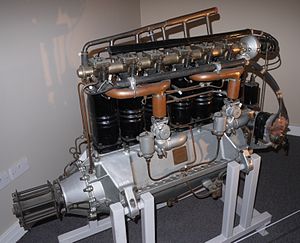

| Hawk | |
|---|---|

| |
| Preserved Rolls-Royce Hawk | |
| Type | Liquid-cooled inline piston engine |
| Manufacturer | Rolls-Royce Limited |
| First run | 1914 |
| Major applications | SSZ class blimp |
| Number built | 205 |
The Rolls-Royce Hawk was a British aero engine designed by Rolls-Royce in 1915. Derived from one bank of six cylinders of the Rolls-Royce Eagle, it produced 75 horsepower at 1,370 rpm. Power was progressively increased to 91 hp by February 1916, and 105 hp by October 1918.[1]
After Rolls-Royce made the prototypes, the Hawk was manufactured under licence by Brazil Straker in Bristol between 1915 and 1918. During this period 204 engines were built, and the Hawk earned a reputation for high reliability.
Many engines of this type were used to power the SSZ class coastal patrol airships of which 76 were built.
Post war one engine (serial number 332) was fitted into a specially built hull and launched on Windermere in 1922 with the name Canfly. With a flywheel added it was directly connected to the boat's propeller without a gearbox. Capable of reaching speeds of 26 knots (30 mph; 48 km/h) Canfly was used as the official's boat at several world speed record attempts during the 1920s and 1930s. The boat and engine are now displayed in a working but non-operational state at the Windermere Jetty museum.[2]
Data from Lumsden[3]
Comparable engines
Related lists
|
| |||||
|---|---|---|---|---|---|
| Piston engines |
| ||||
| Rocket engines |
| ||||
| Turbojets |
| ||||
| Turbofans |
| ||||
| Turboprops/Turboshafts |
| ||||
| Rolls-Royce Barnoldswick (RB) designations |
| ||||
| Aero-derivative industrial and marine engines |
| ||||
| Designers |
| ||||
See also Rolls-Royce Holdings and Rolls-Royce Heritage Trust | |||||